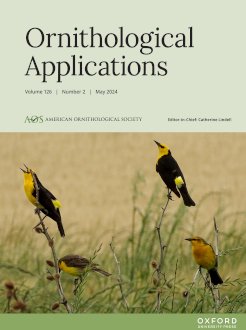The McKay's Bunting (Plectrophenax hyperboreus) is endemic to Alaska, breeds solely on the remote and uninhabited St. Matthew and Hall islands (332 km2) in the central Bering Sea, and is designated as a species of high conservation concern due to its small population size and restricted range. A previous hypothesized population estimate (∼2,800 to 6,000 individuals) was greatly increased (∼31,200 individuals) after systematic surveys of the species' entire breeding range in 2003, establishing McKay's Bunting as one of the rarest passerines in North America. In 2018, we replicated the 2003 surveys and used density surface models to estimate breeding season densities, distributions, and population change over the intervening time period. Our results indicate that the McKay's Bunting population declined by 38% (95% CI: 27 to 48%) from ∼31,560 to 19,481 individuals since 2003. Spatial model predictions showed no areas with an increase of birds on either St. Matthew or Hall islands but revealed declines across 13% (42 km2) of St. Matthew Island. Declines disproportionately occurred both in marginal habitats with reduced rocky nesting substrate and in high-density hotspots along the coast of St. Matthew Island. The total area occupied by breeding adults decreased by 8%, and high-density hotspots shifted inland from the coast of St. Matthew Island to higher elevations on both islands, the latter potentially responses to exceptionally warm weather and reduced spring snow cover in 2018. Additionally, we observed low numbers of predators and interspecific competitors in 2018, suggesting that these did not cause the decline. Our findings indicate that McKay's Bunting meets international standards for elevating its conservation status from Least Concern to Endangered based on the International Union for Conservation of Nature Red List of Threatened Species ranking criteria. Additional population monitoring and studies to identify the causal mechanisms of the recent population decline of this rare species could assist future population assessments.
LAY SUMMARY
Bird populations are declining across the Arctic, but the causes of the declines are not well understood because many of these populations are poorly monitored.
McKay's Bunting is endemic to Alaska and only occurs in the Bering Sea region where its entire population breeds on 2 remote and uninhabited islands.
This species is of conservation concern because it has one of the smallest populations and geographic ranges of any songbird in North America.
We surveyed adult McKay's Buntings across their entire breeding range in 2018 and detected a 38% population decline since 2003 (3% decline per year).
McKay's Bunting meets international criteria to elevate its conservation status to higher classifications of vulnerability.
Plectrophenax hyperboreus es endémica de Alaska, se reproduce únicamente en las remotas e inhabitadas islas St. Matthew y Hall (332 km2) en el Mar de Bering central, y está designada como una especie de gran preocupación para la conservación debido a su pequeño tamaño poblacional y su rango restringido. Una estimación poblacional hipotética realizada con anterioridad (∼2,800–6,000 individuos) aumentó significativamente (∼31,200 individuos) después de realizarse censos sistemáticos en todo el rango reproductivo de la especie en 2003, estableciendo a P. hyperboreus como uno de los paseriformes más raros de América del Norte. En 2018, replicamos los censos de 2003 y utilizamos modelos de superficie de densidad para estimar las densidades en la temporada de cría, las distribuciones y los cambios poblacionales a lo largo del período intermedio. Nuestros resultados indican que la población de P. hyperboreus disminuyó en un 38% (IC del 95%: 27–48%) de ∼31,560 a 19,481 individuos desde 2003. Las predicciones del modelo espacial no mostraron áreas con un aumento de aves en las islas St. Matthew o Hall, y revelaron disminuciones en el 13% (42 km2) de la isla St. Matthew. Las disminuciones ocurrieron desproporcionadamente tanto en hábitats marginales con menor cantidad de sustrato rocoso para anidar como en puntos de alta densidad a lo largo de la costa de la isla St. Matthew. El área total ocupada por adultos reproductores disminuyó un 8%, y los puntos de alta densidad se desplazaron tierra adentro desde la costa de la isla St. Matthew a elevaciones más altas en ambas islas, esto último posiblemente en respuesta a un clima excepcionalmente cálido y a una reducción en la cobertura de nieve en primavera en 2018. Además, observamos bajos números de depredadores y competidores interespecíficos en 2018, lo que sugiere que estos no fueron la causa de la disminución. Nuestros hallazgos indican que P. hyperboreus cumple con los estándares internacionales para elevar su estatus de conservación de Preocupación Menor a En Peligro, según los criterios de clasificación de la Lista Roja de Especies Amenazadas de la Unión Internacional para la Conservación de la Naturaleza. El monitoreo adicional de la población y estudios para identificar los mecanismos causales de la reciente disminución poblacional de esta especie rara podrían ayudar en las evaluaciones poblacionales futuras.






